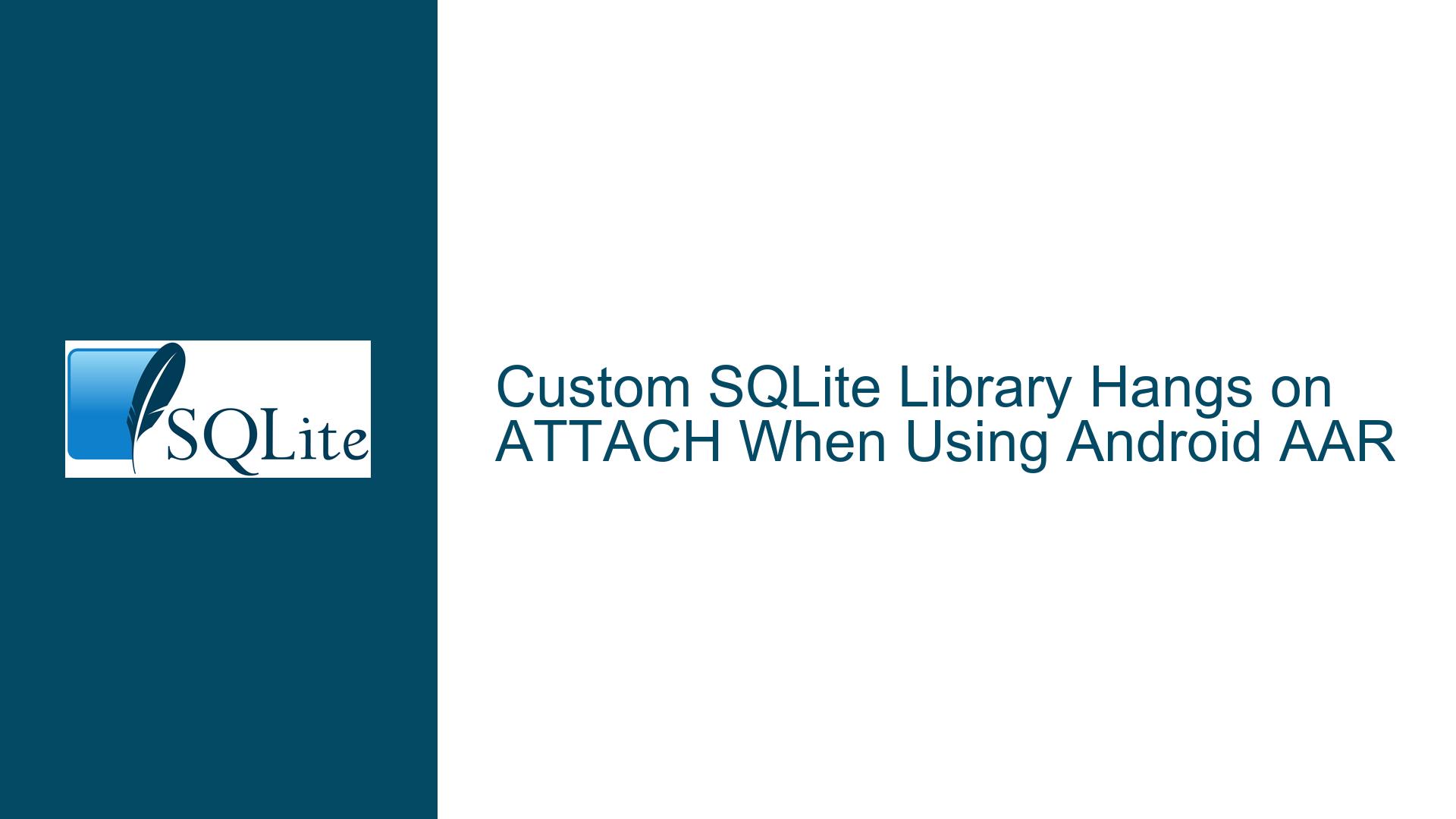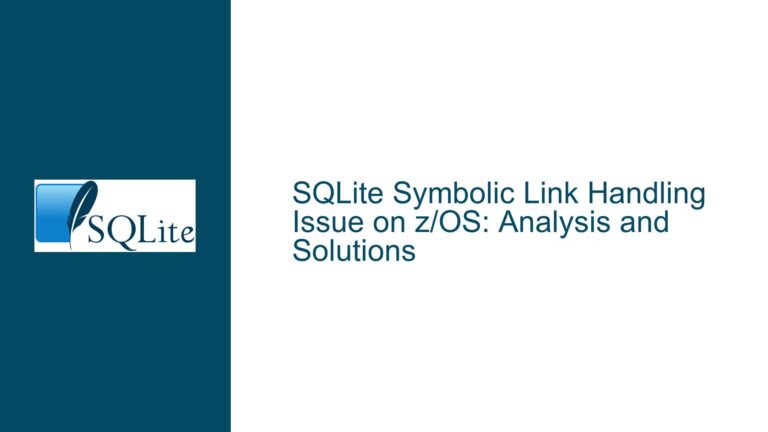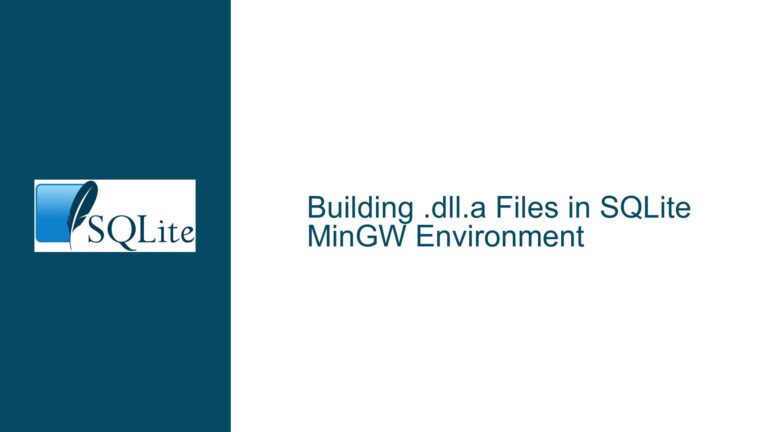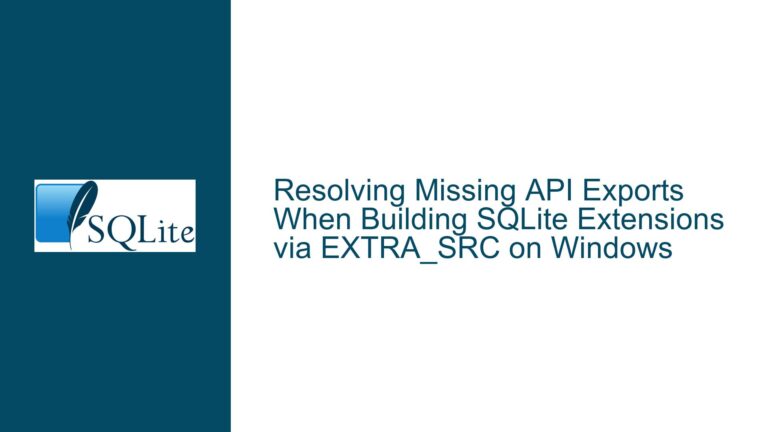Custom SQLite Library Hangs on ATTACH When Using Android AAR
Custom SQLite Library Modifications and Android AAR Integration
The core issue revolves around a custom SQLite library (libsqliteX.so) that has been modified to include a custom URI handler and a pre-update callback. This library is integrated into an Android application using an Android Archive (AAR). The custom library works flawlessly on Linux and Android when using native code, but when integrated with the Android AAR, the ATTACH command causes the application to hang. Specifically, the hang occurs when attempting to attach a non-empty database to the main database file during the sqlite3_open_v2() call. The problem does not manifest when the attached database is empty, suggesting that the issue is related to the interaction between the custom SQLite library, the Android AAR, and the database attachment process.
The custom SQLite library replaces the standard sqlite3_open() and sqlite3_open_v2() functions with custom implementations that handle specific URI patterns (e.g., ourthing://). When a database is opened using this custom URI, the library performs additional operations, including attaching a shared database file and installing a pre-update callback. These operations work correctly in native environments but fail when the library is used within an Android AAR. The failure is isolated to the ATTACH command, which never returns when the attached database contains tables.
Interplay Between Custom SQLite Modifications and Android AAR
The issue likely stems from the interaction between the custom SQLite modifications and the Android AAR integration. Several factors could be contributing to the problem:
Threading and Synchronization Issues: Android applications often use multiple threads to handle database operations. The custom SQLite library might not be handling threading correctly, leading to deadlocks or race conditions when the
ATTACHcommand is executed. The fact that the issue only occurs when the attached database contains tables suggests that the problem might be related to how the library handles schema initialization or table locking.Memory Management Differences: Android’s memory management system differs from that of native Linux environments. The custom SQLite library might be allocating or deallocating memory in a way that is incompatible with Android’s memory management, leading to undefined behavior when the
ATTACHcommand is executed.VFS Layer Incompatibility: The custom SQLite library might be bypassing or improperly interacting with Android’s Virtual File System (VFS) layer. The VFS layer is responsible for handling file operations in SQLite, and any custom modifications to the library must ensure compatibility with this layer. If the custom library is not properly integrated with the VFS layer, it could lead to issues when performing file operations, such as attaching a database.
Callback and Hook Interactions: The custom SQLite library installs a pre-update callback, which might be interfering with the normal operation of the
ATTACHcommand. The callback could be causing the library to enter an infinite loop or deadlock when the attached database contains tables.Build and Linking Issues: The custom SQLite library might not be built or linked correctly for the Android environment. Differences in compiler flags, linking options, or library dependencies could lead to subtle issues that only manifest when the library is used within an Android AAR.
Debugging and Resolving the ATTACH Command Hang
To resolve the issue, a systematic approach to debugging and troubleshooting is required. The following steps outline a detailed process for identifying and fixing the problem:
Step 1: Verify the Custom SQLite Library Build
Before diving into the code, it is essential to ensure that the custom SQLite library is built correctly for the Android environment. This involves verifying the build configuration, compiler flags, and linking options. The library should be built using the Android NDK, with the appropriate target architecture and API level. Additionally, the library should be linked against the correct version of the Android runtime and any other required dependencies.
Step 2: Isolate the ATTACH Command
To isolate the issue, the ATTACH command should be executed independently of the custom SQLite library. This can be done by creating a minimal test case that opens a database connection, attaches a database, and performs a simple query. The test case should be run in both the native environment and the Android environment to identify any differences in behavior.
Step 3: Analyze Threading and Synchronization
Given that the issue only occurs when the attached database contains tables, it is likely related to threading and synchronization. The custom SQLite library should be analyzed to ensure that it handles threading correctly. This includes verifying that all database operations are performed within the correct thread context and that proper synchronization mechanisms are in place to prevent race conditions and deadlocks.
Step 4: Review Memory Management
The custom SQLite library should be reviewed to ensure that it handles memory allocation and deallocation correctly in the Android environment. This includes verifying that all memory allocations are performed using the appropriate Android APIs and that memory is properly released when no longer needed. Tools such as Valgrind or Android’s native memory profiler can be used to identify memory leaks or invalid memory accesses.
Step 5: Investigate VFS Layer Integration
The custom SQLite library should be reviewed to ensure that it properly interacts with Android’s VFS layer. This includes verifying that all file operations are performed using the correct VFS APIs and that the library does not bypass or interfere with the VFS layer. If necessary, the library should be modified to ensure compatibility with the VFS layer.
Step 6: Examine Callback and Hook Interactions
The pre-update callback installed by the custom SQLite library should be examined to ensure that it does not interfere with the normal operation of the ATTACH command. This includes verifying that the callback does not cause the library to enter an infinite loop or deadlock when the attached database contains tables. If necessary, the callback should be modified or disabled to isolate the issue.
Step 7: Implement Logging and Debugging
To aid in debugging, the custom SQLite library should be instrumented with logging statements that track the flow of execution and the state of the database connection. This includes logging the execution of the ATTACH command, the installation of the pre-update callback, and any other relevant operations. The logs should be analyzed to identify any anomalies or unexpected behavior.
Step 8: Test with Different Database Configurations
The issue should be tested with different database configurations to identify any patterns or common factors. This includes testing with different database schemas, table sizes, and data contents. The goal is to identify any specific conditions that trigger the issue and to determine whether the issue is related to the database schema or the data itself.
Step 9: Consult SQLite Documentation and Community
If the issue persists, the SQLite documentation and community should be consulted for additional insights and guidance. This includes reviewing the SQLite documentation on the ATTACH command, the VFS layer, and the pre-update callback. Additionally, the SQLite mailing list and forums can be searched for similar issues and potential solutions.
Step 10: Implement a Workaround
If the issue cannot be resolved immediately, a workaround should be implemented to allow the application to function while further investigation is conducted. One possible workaround is to skip the ATTACH command during the initial database open and instead attach the shared database using the Java interface. This approach has been reported to work in some cases and can serve as a temporary solution until the root cause of the issue is identified and resolved.
Step 11: Refactor the Custom SQLite Library
If the issue is determined to be related to the custom SQLite library, the library should be refactored to address the underlying problem. This may involve rewriting certain portions of the code, modifying the build configuration, or rethinking the approach to handling custom URIs and callbacks. The goal is to create a more robust and reliable implementation that works correctly in both native and Android environments.
Step 12: Perform Regression Testing
Once the issue has been resolved, regression testing should be performed to ensure that the fix does not introduce new issues or regressions. This includes testing the custom SQLite library in both native and Android environments, as well as testing the application with different database configurations and usage scenarios. The goal is to ensure that the fix is stable and reliable and that it does not negatively impact the performance or functionality of the application.
Step 13: Document the Solution
Finally, the solution should be documented to provide a clear and detailed explanation of the issue, the steps taken to resolve it, and the final fix. This documentation should be shared with the development team and any other stakeholders to ensure that the issue is well understood and that similar issues can be avoided in the future.
By following these steps, the issue of the custom SQLite library hanging on the ATTACH command when using an Android AAR can be systematically identified and resolved. The key is to approach the problem methodically, using a combination of debugging, testing, and refactoring to isolate and address the root cause of the issue.






